If you want to learn the meaning of Labradoodle, look closely; it’s in the name! F1 Labradoodles have long been the best choice of dog lovers for their adorable looks and warm personality. However, the only thing that confuses many people is the several generations of these dogs. But don’t worry, we have got your back!
So, what are F1 Labradoodles? What genes do they carry? How to differentiate between different Labradoodle generations? Let’s find out!
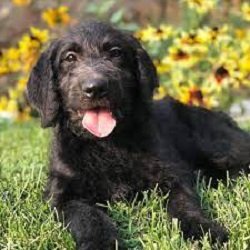
What does Labradoodle mean?
The term Labra is short for purebred Labrador Retriever and the part of word oodle refers to the purebred Poodles. In short, the Labradoodle breed is the cross between 100% Labrador Retriever and 100% Poodle dogs. Simple isn’t it?
Before we proceed, here is a quick look at the difference in traits between Labrador and Poodle.
Qualities of a Labrador Retriever
- They have less curly or a straight coat
- Their coat sheds more than the Poodles
- They are more allergenic
- Good guide dogs
Qualities of a Poodle
- These dogs have curly or wavy hair
- They are non-shedding
- They are more hypoallergenic
Let’s now get to know more about F1 Labradoodles.
What are F1 Labradoodles?
In scientific terms, the letter F in F1 stands for ‘filial generation’ and it describes the relation of an offspring with its ancestors. The term F1 literally means ‘First generation. Similarly, F2 would mean the Second generation, and F3 denotes the Third generation.
I have already stated the meaning of the breed; Labradoodle. It is simply a cross between a purebred Labrador and a Poodle.
Now putting the two together, that is, F1 and Labradoodles, we get F1 Labradoodles, meaning the First generation of the Labradoodle breed. (Offspring produced when a Labrador Retriever and Poodle mate together.)
However, when we are discussing F1 Labradoodles, we can not neglect the other inbred Labradoodles, the F2 and F3 generations.
Let’s begin!

Different generations of Labradoodle
Note: Be it humans or dogs, the criteria for defining the sequence of generations remains the same.
Believe it or not but in the world of science, these criteria make it so much easier to understand the concept of several generations. Don’t worry you will get it as well!
F1 Labradoodle
As we stated earlier, F1 Labradoodle is an outcome of a purebred Labrador with a purebred Poodle. This means that an F1 Labradoodle inherits 50% genetics from a Labrador Retriever and 50% from Poodle.
Since the F1 Labradoodle is inheriting half of the genes from each parent, there are higher chances of genetic variations. This is because the 50% of genes that it inherits from both parents can either contain a dominant trait or a recessive one.
For example, if your dog inherits 50% of traits from the Poodle parent, we don’t know whether this 50% would be from the dominant or the hidden traits. Plus, we can’t tell which genes would turn out dominant in the offspring.
Hence, your dog can have a straight, curly, or wavy coat and can attain shedding or non-shedding characteristics. This is why it is hard to predict the exact characteristics of an unborn Labradoodle.
However, F1 Labradoodle has one superior characteristic over the other generations. All the F1 generation Labradoodles are more resistant to genetic disorders and have better health than their purebred parents. This is because the purebred dogs are a cross between two dogs of similar races.
Remember: The closer the relationship is, the higher are the chances of newborns inheriting genetic deformities!
Therefore, a purebred dog, be it Poodle or Labrador retriever, is less healthy and more prone to abnormalities than a hybrid dog. Hence, F1 Labradoodles are healthier offspring with a high hybrid vigor as the cross is between two different breeds.
This is one of the reasons why many dog owners seek the F1 (that is the First generation) Labradoodles.
Note: As we move ahead, the quality of Hybrid vigor will reduce. According to experts, the more we intermix the genes, the more diseases we transfer to the progeny.
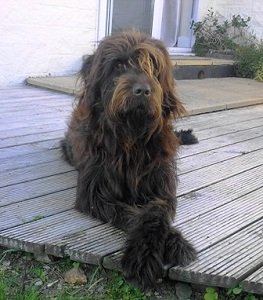
F1B Labradoodle
The F1B Labradoodle is the second generation of Labradoodles. Well, that might get confusing for some people but once you understand the concept of labeling generations, it becomes easier to determine what generation your dog belongs to.
Firstly, the letter B in F1B is short for Backcross. And Backcross means breeding a mixed offspring back to its purebred ancestor. Hence, in this case, F1B Labradoodle is a cross product of F1 labradoodle with 100% purebred Labrador or Poodle.
Note: Most breeders prefer poodles for backcrossing due to their non-shedding, hypoallergenic qualities as opposed to Labradors.
In short, in the scientific world, F1B Labradoodle refers to breeding between F1 Labradoodle and a 100% pure Poodle. Therefore, we would most likely get 75% of Poodle genes and 25% Labrador retriever traits.
If you are allergic to dog fur, F1B Labradoodle might be the second-best choice for you. However, the only disadvantage of owning an F1B Labradoodle is that they don’t shed that often. Hence, you would have to wash and brush them every other day and give them a haircut more often. Sounds like work!
Moreover, they have a curly coat that might easily get entangled. Once that happens, you would have to shave the whole coat from the roots, leaving only the skin behind.
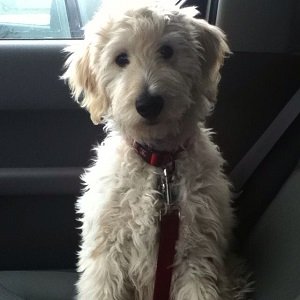
F1BB Labradoodle
F1BB Labradoodles are a result of crossing an F1B Labradoodle back to a 100% purebred labradoodle, mostly poodle. The two Bs refer to the two Backcrossed generations. Moreover, F1BB comes under the third generation of Labradoodles and has around 87.5% genetics of poodles with the remaining 12.5% of Labrador retrievers.
These genetics make them the best choice for people who are sensitive to dog furs. Besides, they are less messy and you won’t find dog hair everywhere around the house. This is because these F1BB Labradoodles acquire most characteristics of Poodles, therefore, their coats are entirely non-shedding.
This brings us to the bad news!
Since they don’t shed themselves, you would have to give them a haircut so often and brush them even more regularly than F1B Labradoodles. Sounds like a lot of work!
Furthermore, F1BB Labradoodles are more susceptible to developing hereditary disorders as the genes are very much closely related (around 87% from the same parent). For this reason, F1BB Labradoodles have the least Hybrid vigor of all F1 Labradoodle generations.
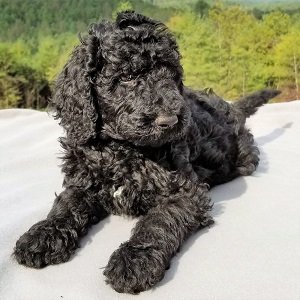
F2 Labradoodle
Now moving on to another generation, that is, F2 Labradoodles. F2 Labradoodles make the second generation of this hybrid. This Labradoodle generation has a cross between two F1 Labradoodles with 50% genetics from each breed.
You now already know from the above discussion that F1 Labradoodles inherit unpredictable genes from each parent. However, F2 Labradoodles have the most variable genes out of all.
This is because we are now breeding two dogs, both with high genetic variations and unpredictability. Therefore, it’s very unlikely for an expert breeder to breed F2 Labradoodles. The result might surprise you.
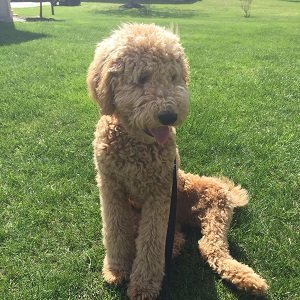
F2B Labradoodle
F2B Labradoodle is the third generation of Labradoodles. And we get an F2B Labradoodle by mating an F1 Labradoodle (with 50/50 genes) with an F1B Labradoodle (with 75% of Poodle genes). The resultant progeny gets around 62.5% of Poodle traits and 37.5% of Labradors retriever genetics. In short, this F2 generation also attains more good traits from the Poodle side.
Some breeders also breed the two F1B Labradoodles together to attain most of the qualities of a Poodle dog. However, this practice is less common, maybe because of the risk associated with cross-linking of two closely related genes.
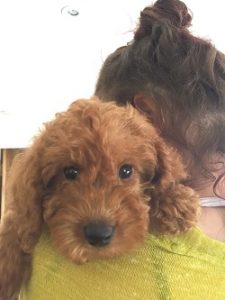
F2BB Labradoodle
The F2BB generation is technically the fourth generation Labradoodles or most would like to count it among the Multi-generation category. Simply, F2BB Labradoodles are produced by mating an F2B Labradoodle back to its 100% purebred Poodle, as most breeders would prefer.
These dogs enjoy 81% of the inherited pool from the Poodle side. Therefore, this characteristic makes them stand second to F1BB Labradoodles in being most closely related to poodles.
Furthermore, they are extremely hypoallergenic, non-shedding, and, in fact, the most suitable dog in the second generation (F2) for hypersensitive people.
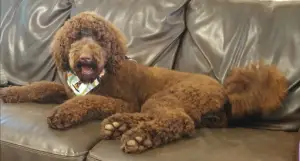
F3 Labradoodle
How many more generations of Labradoodle? Well as many as you can manage to see in this lifetime. F3 Labradoodle is officially the Multi-generation labradoodle. What is the Multi-generation category of Labradoodles?
Well, in easy words, Multi-generation includes those Labradoodles that have passed the second generation since they are technically the product of several generations including; Labrador retriever, Poodles, and Labradoodles.
Note: Many breeders interchangeably use the term Multi-generation for third-generation Labradoodles. So, whenever you decide on buying a Labradoodle and the breeder uses the word ‘Multi, ask them for more details regarding the sequence of generation and what exactly do they mean by Multi.
The F3 Labradoodles typically include F1BB, F2B, and F2BB Labradoodles – all the third generations. Moreover, if you remember the genetics we mentioned earlier about these breeds, you know that all these F1 and F2 Labradoodles contain the highest percentage of Poodles.
Hence, these are the choice of many people and are the most suitable options for people with dog allergies.
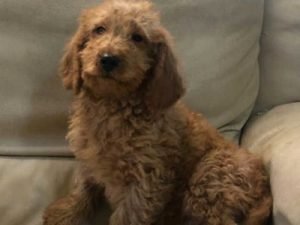
Here is a summarized table of all the generations of Labradoodles:
| Labradoodle Generation Type | Fur Coat Type | Allergenicity | Shedding vs Non-shedding | Hybrid Vigor |
| F1 Labradoodle | Variable (can be straight, wavy, or curly) | Variable | Variable | Posses the most Hybrid vigor trait of all |
| F1B Labradoodle | Wavy or Curly | Hypoallergenic | Non-shedding | Less Hybrid vigor than F1 |
| F1BB Labradoodle | Curly Fur coat | Most Hypoallergenic breeds of first-generation Labradoodles | Non-shedding | Least Hybrid vigor characteristic of first-generation Labradoodles |
| F2 Labradoodle | Highly variable | Variable and mostly unpredictable | Variable | Less Hybrid vigor than F1 generation |
| F2B Labradoodle | Wavy or curly | Mostly hypoallergenic | Mostly Non-shedding | Less Hybrid vigor than F1 generation |
| F2BB Labradoodle | Curly | Least allergenic among the second generation Labradoodles | Least shedding dogs out of the F2 generation | Less Hybrid vigor than F1 generation |
| F3 Labradoodle | Mostly curly | Hypoallergenic | Non-shedding | No hybrid vigor characteristic |
Can F1 Labradoodles Shed or Not?
Whether your F1 labradoodle will shed its fur or not truly depends on the percentage of genes it inherited from parents. If there are more labrador retriever’s genes in the offspring, your labradoodle will definitely shed, less or more, again varying from generation to generation.
However, an F1 Labradoodle will obviously shed since there are 50% genes inherited from the retriever side.
Note: Generally, a dog with a flat coat tends to shed more than a dog with a curly or wavy coat. Therefore, if your labradoodle has inherited much of the retriever’s side, it is going to shed more.
Your allergies must never get in the way of adopting a dog. Now someone who is allergic to furs must get concerned about the allergic reaction they may encounter. But don’t worry, you can minimize the amount of shedding simply by following these tips:
- Regularly brush the pet’s hair
- Give them a shower every other day
- Take care of their nutrition and provide them with a balanced diet
Above all, don’t forget to ask the breeder about the parent dogs before buying a labradoodle.
Are F1 Labradoodles Good Pets?
Good question, F1 Labradoodles are the best choice for many dog owners. The labradoodle puppies are adored by many dog-lovers and not going to lie, they are truly adorable. They almost melt your heart every time you look at them.
But, sadly these dogs are not the best choice for hyperallergic people. If you like Labradoodles you can invest in other generations but F1 Labradoodles, being the mixture of Labrador and Poodle, have a 50% chance of causing allergies.
However, the F1 Labradoodles have all the qualities of a good dog. They not only have cute looks but are loyal, loving, and always give you a warm welcome. In fact, F1 Labradoodles are sometimes used as therapy dogs for their great stress-relieving power and playful personality. Surely a powerful stress-reliever.
Moreover, as we mentioned earlier, purebred Labrador Retrievers have remarkable guiding abilities. Hence, F1 Labradoodles with 50% Labrador genes also make good guide dogs.
The best part? These cross-bred Labradoodles have the highest hybrid vigor out of all the other generations. Pheww one less concern about your pet’s health!
Which Labradoodle Generations are the Best?
In short, if it really comes to choosing the best generation, the one with the least shedding and hypoallergenic trait should be your top pick. The three most suitable generations that fit this category are:
- F1B Labradoodle with 75% Poodle genes
- F1BB Labradoodle with 87.5% Poodle genes
- F2BB Labradoodles with around 81% Poodle genes
However, needless to mention, go for what suits you the best. If you are not allergic to the dog’s fur and are fine with a straight coat as well, there is no harm in choosing a dog with more Labrador Retriever genetics. This way you find a great guide dog dressed up as Poodle.
Conclusion
So, that was all about Labradoodles and the differences in their generations. At the end of the day, it all comes down to your preference and what traits you consider the best. But I recommend you always talk to the breeder first before investing in an F1 Labradoodle, as they have more information regarding a particular breed and its genetics. If you’re allergic and start your day with spells of sneezing then go for hypoallergenic generations example F3 Labradoodle. However, if you want more of a guide dog then, how about an F1 Labradoodle?

